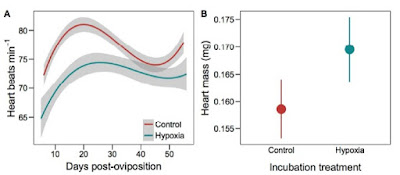Développement à haute altitude (Development at high altitudes)
DOES PHYSIOLOGY PROMOTE EMBRYONIC DEVELOPMENT IN
HIGH-ALTITUDE ENVIRONMENTS?
Post by
Antonio Cordero
Physiological responses that
ensure survival during environmentally sensitive life stages are crucial to
populations experiencing climate change. However, how developing organisms deal
with environmental variability is poorly known. In particular, little is known
about how ectothermic vertebrates, such as reptiles, cope with high-altitude
hypoxia. In 2016, we studied the common wall lizard (Podarcis muralis) to address this concern (manuscript currently in
review with the Biological Journal of the Linnean Society). We learned that
developing lizards exposed to naturally occurring hypoxia (15-16% O2 sea
level equivalent) at ~2900 m above sea level may slow down their metabolism and
employ cardiovascular adjustments that may assist in the maintenance of proper
oxygen consumption. For example, developing lizards in high-altitude hypoxia
decreased their heart rate and thus hatched with slightly heavier hearts (see
figure below). These responses enabled lizards to grow to a size that was only slightly
smaller their siblings at low elevation (21% O2; 300-500 m above sea
level). However, the amount of energy lizards consumed in the egg was metabolically
disrupted by hypoxia, thus we don’t fully understand whether plastic compensatory
responses have long-term detrimental effects. We therefore concluded that flexibility
in physiological responses to hypoxia may contribute to the survival and normal
growth of developing lizards, but more work is need to determine how this might
influence how populations adapt to high altitude.
 |
| Some results from our study currently in review. Note that eggs in hypoxia had lower heart rates, but larger hearts. |
Last year’s project was a team effort by master student Bea Andersson, myself, and our supervisor Tobias Uller form the Department of Biology of Lund University. Of course, CNRS researchers Fabien Aubret and Jeremie Souchet played an integral role in completing the project. We had to collect female lizards from low elevation and prepare just the right conditions for them to lay eggs in the lab. Then we transplanted these low-elevation eggs to a high-elevation laboratory in the majestic Pic du Midi. This was a major undertaking that required long work hours and careful planning. In fact, these sorts of experiments are rarely executed and ours was the first to transplant reptilian eggs to a high-elevation hypoxic environment. Yet there is much more to be learned.
This year I pass on the torch
to my good friend and colleague Eric Gangloff. I’m currently helping Eric set
up an exciting experiment aiming to determine whether high-elevation hypoxia is
indeed detrimental to the physiology of adult lizards. Next year we hope to
perform another developmental experiment on lizard females just before they lay
their eggs. Collectively, our experiments will paint a clearer picture of how
reptiles may respond to climate warming in mountain refugia.
 |
| Antonio looks for bearded vultures from Pic du Midi. |


Comments
Post a Comment